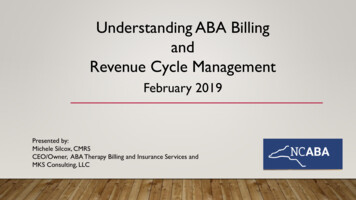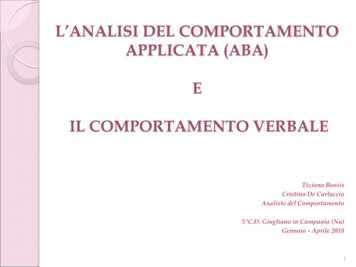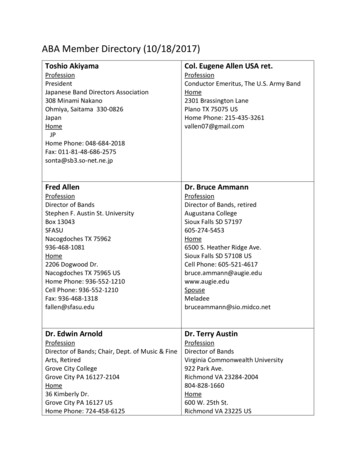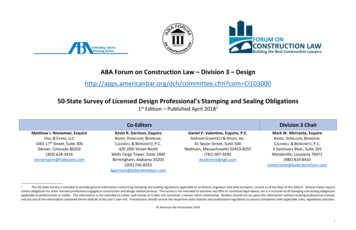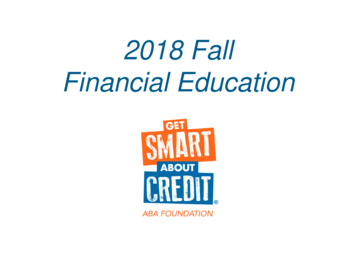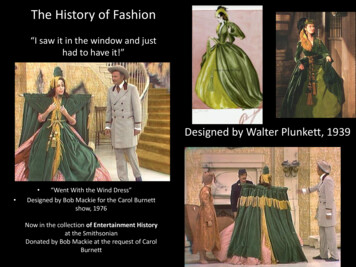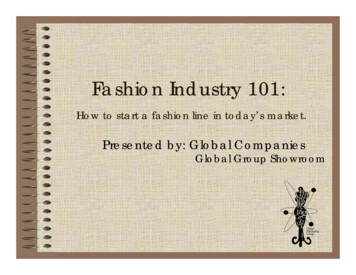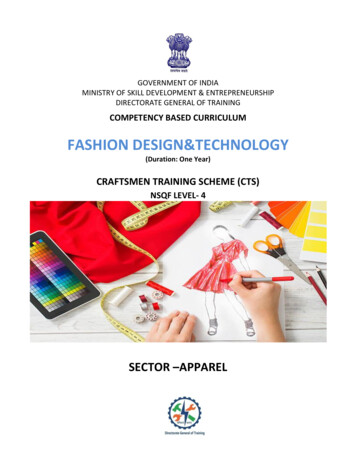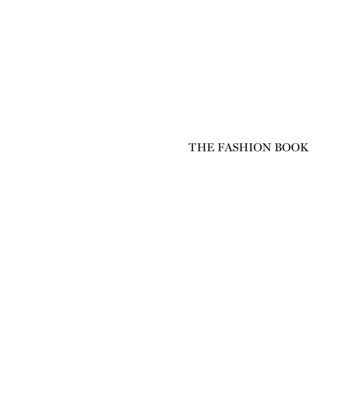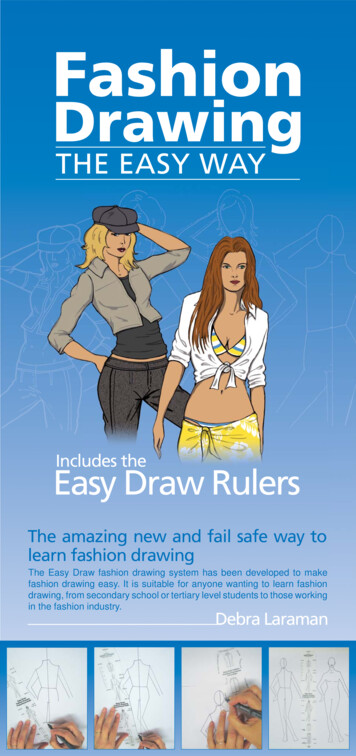
Transcription
FashionDrawingTHE EASY WAYIncludes theEasy Draw RulersThe amazing new and fail safe way tolearn fashion drawingThe Easy Draw fashion drawing system has been developed to makefashion drawing easy. It is suitable for anyone wanting to learn fashiondrawing, from secondary school or tertiary level students to those workingin the fashion industry.Debra Laraman
ISBN 1-877386-47-2Copyright 2006 ABA Books LtdCopyright 2006 Debra LaramanPublished by ABA Books LtdText, photographs and illustrations by Debra LaramanPrinted in Singapore by Markono Print Media Pte LtdAll rights reserved. No part of this publication may be reproduced, stored in a retrieval systemor transmitted in any form or by any means, electrical, mechanical, photocopying, recording orotherwise, without the prior permission of ABA Books Ltd.Copies of this book are available direct from:ABA Resources LtdOffice: 2d/6 Brooklyn Rd, Claudelands, Hamilton, New ZealandPostal: PO Box 11-099, Hamilton, New ZealandPhone: 64 7 854 9360Fax: 64 7 854 9361Mobile: 0274 521 942Email: kay@abaresources.co.nzWebsite: www.abaresources.co.nz
FashionDrawingthe Easy WayThe Easy Draw proportional ruler system of fashion drawing and the accompanyinginstructional manual have been developed to allow anyone to produce accuratefashion drawings in a minimum time frame. It is suitable for the beginner or themore experienced illustrator looking for additional tools and methods to improvetheir drawing skills. The ruler will allow you to produce accurately proportionedfashion figures and working drawings (flats). The ability to accurately reflect yourdesign ideas and produce good quality illustrations is paramount to the fashionIndustry.Working drawings are used in the Industry throughout the design and manufactureprocess. The working drawing is used to communicate ideas from the designer’s firstsketches through to the designs to be made by thepattern maker, sample machinist and through eachstep of the production process. Today, many fashionhouses use contractors to manufacture the garmentsboth locally and overseas, therefore the technicalworking drawing is imperative to ensure the endproduct matches the original design in style, finishingand proportion. Working drawings are also used asa selling tool and feature in order guides, mail ordercatalogues, internet sites and by wholesalers selling tothe retail markets.The Easy Draw method of fashion drawing is suitable for any student of fashiondesign at either a secondary or tertiary level. It is a great aid for those working inthe industry who want a quick and accurate tool and will expedite the process ofdrawing by ensuring all garments are accurate and symmetrical. The system is veryeasy to use and would assist those with little experience or those wishing to build ontheir drawing skills.The booklet and ruler system is intended to take you step by step through astructured and systematic method of drawing that will allow you to achieve a goodresult in a minimum of time.It is important to read the section on how to use the rulers (refer to pages 2 and 3)and then follow the Getting Started exercises on pages 4 - 18 to familiarise yourselfwith the options.Once you have mastered the concept you can extend your skills in the exercises frompages 22 - 56.Getting Startedi
Author’s noteFashion drawing is an excellent method of developing and realising yourdesign ideas. It allows you to visually play with design lines and featureswithout the need to make costly samples. Good quality technical drawingsare imperative for the industry, yet many people struggle with their drawingabilities and often lack confidence in their skills. This system has beendeveloped to allow anyone to overcome the difficulties that they may haveencountered with freehand drawing, by following a systematic approach andthe use of the ruler system.In producing this system I have had the opportunity to draw on mybackground in the fashion industry and my experience of teaching fashionand design in an educational institute. I have had the opportunity to workwith students and see the results that they have achieved through the manytrials of developing this method.The system was developed using the fashion proportions based on the 8½head canon as the ideal proportions of the fashion figure. The averagehuman is between 7½ - 8 heads in height (referred to as the canon). Fashionfigures generally have additional length added in the legs to give a moredramatic and stylised look. Once you have mastered the Easy Draw systemyou should have the confidence to develop your own style further and therulers will be a valuable aid in your future drawings and illustrations.I wish you success for the future.Debra LaramanProgramme Co-ordinatorDiploma in Fashion Design TechnologyGroup Leader- Design ProgrammesBay of Plenty PolytechnicTaurangaNew ZealandAcknowledgementsI would like to thank the following people for their contribution in makingthis project possible. Bay of Plenty Polytechnic, Tauranga. Suze Higgins for graphic design and desktop publishing. Miranda Wheatley for being the hand model. Melissa Gibbard for photography. Dr Brian Coffey - Director, Pacific Coast Applied Research Centre, for hissupport and encouragement and for proof reading this book.iiGetting Started
IndexINTRODUCTIONEquipment . 1Useful Items . 1Optional / Additional Items . 1Easy Draw Rulers - Diagram and Explanation of Use . 2GETTING STARTEDExercise 1 – Instructions for Proportional Figure Template . 4Fashion Figure – Changing the Stance . 8Exercise 2 – Instructions for Changing the Stance . 9Exercise 3 – Instructions for a Straight Skirt.12Exercise 4 – Instructions for a Basic Trouser .14Exercise 5 – Instructions for a Skirt with Inverted Pleats .16Exercise 6 – Instructions for a Fitted Jacket with Shawl Collar .18EXTENDING YOUR SKILLSExercise 7 – Basic Short .22Exercise 8 – Jean Short .23Exercise 9 – Knee Length Capri Pants .25Exercise 10 – Prairie Skirt.26Exercise 11 – T Shirt.27Exercise 12 – Shirt.28DRESSING THE FASHION FIGUREExercise 13 to 19 – Dressing the Fashion Figure.30DRESSING THE FASHION FIGUREExercise 20 – Basic Figures to Fleshed Out .40Exercise 21 – Basic Figure to Dressed Illustration .41Exercise 22 – Basic Figure to Dressed Fashion Illustration.42Exercise 23 – Basic Figure to Coloured Illustration .43Exercise 24 – Basic Figure to Coloured Illustration .44Exercise 25 – Basic Figure to Coloured Illustration .45Exercise 26 – Basic Figure to Coloured Illustration .46DRAWING A FACEExercise 27 – Step by Step Instructions for Drawing a Face .47Exercise 28 – Facial Styles .50LIBRARYWorking Drawings.51Changing the Style .51Library .52Indexiii
iv
It is not necessary to have a large art kitbut the following items are essential.Equipment Propelling pencil – with either a0.7mm or 0.5mm lead. Black ink fine liners /pigment linersSize 0.1mm, 0.3mm, 0.5mm, 0.8mm.These can also be purchased in akit with nibs ranging from 0.1mmthrough to 0.8mm. Eraser Bank paper/layout paper is bestfor your first drawings as it is semitransparent. Cartridge paper/sketch book A3 sizeis preferred as it is easy to carry and issuitable for pencil and markers andcan be used for finished illustrations.Useful itemsLight box – used for tracing over youroriginal drawings to refine and developthe illustrations.These can be bought from good artstores. An A3 size is recommended that islightweight and portable.Optional /additional itemsYou may wish to extend your skills andadd colour to your illustrations.While this book is not intended to teachyou all about fashion illustration andcolouring techniques, it does show someexamples of coloured artwork that havebeen completed in marker pen and/orcoloured pencil.Marker pens – Suggested colours – askin tone, a blonde or brunette colourfor the hair, a silver, mid and charcoalgrey for adding tone and a mix of yourpreferred colours for clothing.Coloured pencils – boxed set of 72colours is the most economical way topurchase.Aquarelle pencils are versatile as theymay be used dry or by adding water so awatercolour effect can be achieved.Introduction1
Easy Draw Rulers çDiagram and Explanation of UseProportional RulerWaist and hip shapingUsed for drawing bodies and garments; i.e. The lowerbody and garments such as skirts and trousers.Leg lengthsThis area is usedfor garments; theproportions are forlengths of skirts,trousers and shorts.Body proportionsSleeve lengthsThis area is used togive the proportionsof the body. It is usedwhen drawing figuresand garments. You willbegin your drawings byruling down this sidefrom the head to thetoe positions, to ensureaccurate figure andgarment proportions.This line will thenbecome the centre frontand will be matched upwith the dotted line inthe centre of the rulerto ensure garments andfigures are symmetrical.This area is always stepone in the drawingexercises.This area is used fordrawing the upperbody of figures andfor upper garmentssuch as jackets,shirts and tops.The proportionsare marked forthe underarm,sleeve lengths,neck width andshoulder width.Shoulder shaping areaIncludes neck and shoulder widthsused for figures and garments.2Easy Draw Fashion Rulers
Easy Draw Rulers çDiagram and Explanation of UseCurve RulerThe curve ruler is mainly used to give the correct shaping togarments. It also has the template for the head shaping whenyou are drawing figures.Waist shapingWaist bands and any curvelines such as darts, hems andarm/shoulder shaping.Hip shapingUsed for side bodyand darts, pocketsshaping andnecklines.NecklinesNecklinesNecklines andcurve lines.Princess lineHead shapingUsed in conjunctionwith the proportionalruler to give thecorrect shape andsize to the head.Dart shaping, sidebody shaping,lapels, collars andstyle lines.Back neck shapingHemlinesFor collars and jackets.Curves, darts, yokesand waistbands.Easy Draw Fashion Rulers3
E X E R C I SE1Instructions forProportionalFigure Templatestep one Position the ruler with the waist linefacing the top of your page. Draw down the right side of the rulerfrom the ‘head’ position to the ‘toe’position. Mark and name each of thepoints (e.g. neck, waist, bust, hip, knee,ankle and toe).NOTE: This line will become the centrefront line of your drawing.step two Turn the ruler around and place theneck shaping area of the ruler at thechin position. Draw across the ruler from theshoulder point, across the neckshaping, to the other shoulder point.NOTE: Ensure the centre front is alignedcorrectly. To align the ruler correctly, placethe dotted line in the centre of the rulerdirectly on top of the centre front line onyour page, this will ensure your drawingis symmetrical.step three Position the ruler with the waistlinearea of the ruler at the waist positionon your page. Draw across the waistline and downboth sides of the ruler to the ankleposition.NOTE: Remember to always match thecentre front line!4Getting Started
EXERCISE1step four At the ankle position, measure out1cm from the centre front line for bothsides (this is the inside leg position). Match the crotch position on yourruler with the crotch position on thecentre front line and rule down to theankle position for both sides. This is theinside leg.step five Turn the ruler around so that the neckshaping area faces the top of the page.Match the shoulder point on the rulerwith the shoulder position on yourpage and rule down from this positionto the waistline (this is the side body). Mark the underarm position. Complete this process for both sides.step six At the hip position, measure out 3.5cmfrom the centre front line for bothsides (this is the inside wrist position).Getting Started5
E X E R C I SE1step seven Position the ruler so that the underarmposition and the wrist position arematched correctly and rule in theinside arm. Complete for both sides.step eight Match the sho
fashion figures and working drawings (flats). The ability to accurately reflect your design ideas and produce good quality illustrations is paramount to the fashion Industry. Working drawings are used in the Industry throughout the design and manufacture process. The working drawing is used to communicate ideas from the designer’s first


